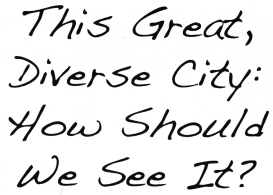 |
 |
| Journal of the Print World, 2011 Volume 34 Number 3 July 2011 |

 |
By Carrie Wilson This exhibition—eighty works by twenty contemporary photographers—is an original, delightful, and engrossing tribute to this city where beauty is to be found not only in its great architecture, but in many unexpected places—a Soho fire-escape by Perry Hall; a jaunty, yellow-legged seagull on a railing near Ellis Island by Dan McClung; an abandoned Coney Island ride by Ralph Toporoff; an awe-inspiring water tower by Michelle Rick; a chili dog stand at night by Harvey Spears. And one of the glories of New York, that it has the most diverse population of people anywhere in the world, is richly represented. We see people riding the subway, rowing in Central Park, walking dogs, reading, waiting for a parade, marching to protest a war—all are shown as part of a world to be known and cared for. The basis of this show is in these sentences from an Aesthetic Realism talk by Eli Siegel titled What of New York and Poetry? He said that in New York, “there is a oneness of quiet and tumult, profundities and mischief. It begins with geography, and then there are twirls and manifestations; surprises within the absolute….You can use a point to get to the whole world, and New York is a good place to begin to be fair to reality as such.” |
|
|
The Terrain, which opened in 1955, was one of the first galleries to see and show photography as a fine art. And for this exhibition, as has been the gallery’s custom, the artists have commented on their works—here in relation to the sentences above and the Terrain Gallery motto, Eli Siegel’s statement, “In reality, opposites are one; art shows this.” Commenting on the phrase, “there is a oneness of quiet and tumult, profundities and mischief,” Adam Isler writes of his photo of children in a playground in Riverside Park: “Singin’ in the Rain captures the profundities and mischief of New York. The children are focused on a profound point at the tip of a finger, and yet, as they sit like some philosophers in Raphael’s School of Athens, the sheer mischief of their romp in the rain is inescapable.” |
And David Bernstein writes of Katz’s Deli, 1984: “One quiet June evening, I was walking on Houston Street with my view camera, eager to see those moments when daylight is in the sky as evening is near—the ‘quiet and tumult’ of New York at twilight. As I passed Katz’s Deli, I was taken by the neon sign, the glowing lights and bright interior, all lit up like a lively festival in the solitude and shadows of the fast approaching twilight. And then in the midst were those dignified and mischievous salamis and sausages hanging vertically in neat rows. The ‘profundities and mischief’ of New York continue to thrill me after all these years.” Aesthetic Realism shows how art represents the way of seeing that things deserve, and everyone hopes for. It is the opponent of the desire to have contempt—the enemy of beauty and justice. The Terrain Gallery is proud to have this idea better known through this powerful and inspiring exhibition. The Terrain is at 141 Greene St., off W. Houston, NYC; 212.777.4490; hours: Wed.-Fri., 12 to 5, Sat. 12 to 4. www.terraingallery.org. |